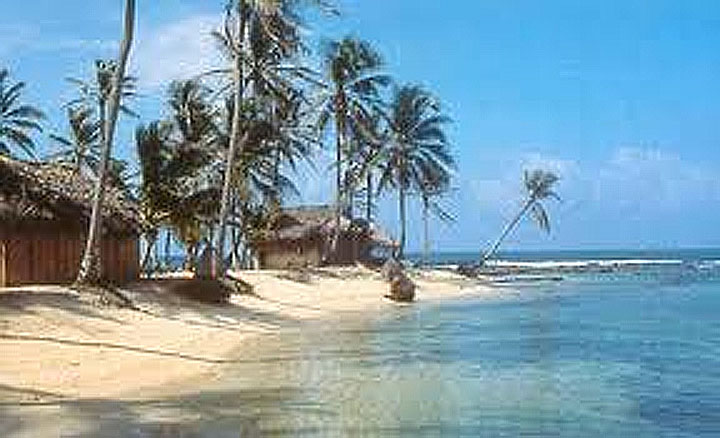|
|---|
Bocas del Toro, Panama - Like the South Pacific, But Much Closer to Home |
Broken News
Chinchilla Cool on Calero Caper Cooperation
(Sorry, but I do have fun with these headlines. In my next life GG wants to be a cub reporter for the New York Herald in the 1930's)
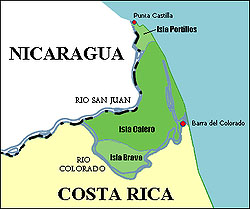 |
|---|
For those of you who have been following the story, Nicaragua and Costa Rica have been in a continuing dispute for more than two years over the Nicas taking of Isla Calero, a small Costa Rican island on the northeastern border between the two countries. It was first reported in the Chronicles in December 2010 and updated several times thereafter. The unstated objective of this travesty was to allow Nicaragua to construct a new mouth for the San Juan river. This meant shorter access to the caribbean in preparation for building a new Caribbean-Pacific canal in direct competition to the Panama Canal. But the Nicas didn't bother to negotiate a right of way, they just took it.
Costa Rica immediately filed a complaint with the World Court who have been vigorously pursuing a ruling (yeah, right) that Nica President Daniel Ortega has already said he will ignore. Now, after his reelection, which was partly successful based on how tough he appeared to be, Danny has made a proposal to Tica president Laura Chinchilla to join him at the border so that they can be together for the issuance of the court ruling which is expected soon.
La Presidenta Laura rejected Danny's advances forthright (good going girl). Evidently Danny is backing off his statements that he used to advance his position during his reelection, The latest move is an attempt to soften the issue and reach a compromise favorable to Nicaragua. I guess that means they still intend to keep the island.
Here's a compromise for you Danny, get the hell off the island you stole!
Perspicacious Pricing
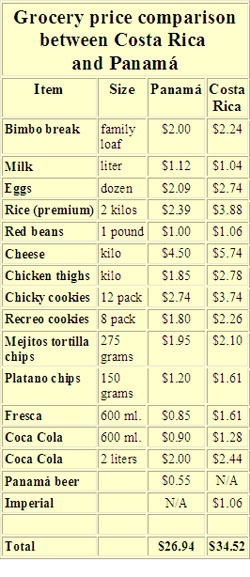 |
|---|
COL Basket for CR +28% |
If you move around Central America you will notice that Costa Rica does not show leadership in low cost of living (I have a Master's in Understatement Science). It may have been the case that the country was cheap 10 or 20 years ago but it's definitely not the situation now.
This is particularly true in food costs. The report to the right was the result of a study conducted by AM Costa Rica recently. The data is based on comparing a typical market basket at a chain supermarket in the center of Panama City with an almost exact market basket at a Mas X Menos in the center of San José.
The market basket sample shown ended up being 28% more expensive in Costa Rica than in Panama.
Some of the differences are startling. Rice, for example is 62% more expensive in Costa Rica thanks to the CR government's rice support program, chicken is 50% more and the standard bottle of beer 93%. Considering the importance, or at least the frequency, of these three items in the Costa Rican diet, the real difference in COL would be even more pronounced than the 28% mentioned.
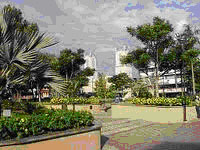 |
|---|
David, Panama Central Park |
These difference are also confirmed by experience. David (pronounced Dah-veed), a city of about 150,000 in its greater metropolitan area, is only about 20 miles south of the Costa Rican border with Panama which makes it a popular destination for those unofficial residents here who need to meet the CR visa renewal requirement of leaving the country every 90 days.
GG made three trips to David for visa renewal and other ROMEOS and friends here have done the same. All report the same results after shopping there. The difference is even more significant when compared to numbers in the Quepos/Manuel Antonio area - closer to 40%.
For more comparative information on Panama and Costa Rica and other retirement destinations see the article in last month's GGC called: Rating Retirement;
Festival de Esferas
The Tico proclivity for festivals, fiestas and assorted mass parties has often been mentioned in the Chronicles.
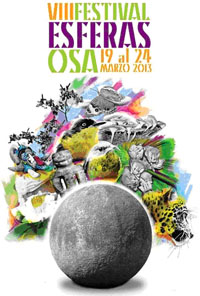 |
|---|
There are events to celebrate Horses (Tope in San José), Mules (Festival de Mulas in Parrita), Whales (Festival de Ballenas in Uvita), Dogs (Curridibat) and probably many other kinds of animals. There are also fiestas for Art (Festival de Artes in San José), and various types of food (Gallo Pinto, Fried Rice, Chichirón) and also to celebrate towns like Quepos and San José. If Ticos can think of a reason, there'll be a festival for it. Let the good times roll, amigos.
In March there was a Festival de Esferas or Festival of Spheres held in the towns of Palmar Norte, Palmar Sur and Ciudad Cortés in the Osa peninsula. This one is centered around those Balls of Stone believed to have been carved by indians in pre-columbian time.
The festival is held in the Osa because many of the spheres were originally found there and the area is also the future site of a national museum which will house the ever increasing number of spheres being found. Activities at the festival are reported to have included foot races, seminars on biology and archaeology. a music workshops and a reenactment of the Spanish being run out of town by bulls (there's still a resentment towards the Spanish here, even among the bulls)..
Personally I'm still waiting for the Festival de Perisozos or Festival of Sloths. The organizers will probably need four days rather than three to make it happen because the dudes move so sloooooow...ly (yuk, yuk).
¡Pura Vida!
Rumble Talk
(Shaky Happenings On or About the Pacific Rim)
A Bump in the Osa
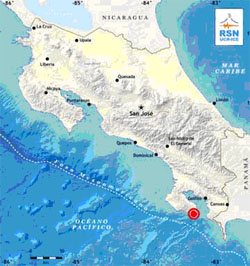 |
|---|
There was a quick but strong jolt that hit the Osa peninsula in March not very far from Puerto Jiménez. The map to the left shows the location of the epicenter as a red dot. The second black dot north of the red dot is Quepos.
There are two government organizations that measure and monitor earthquakes in Costa Rica, the Laboratorio de Ingeniería Sísmica (Seismic Engineering Laboratory) at the Universidad de Costa Rica.and the Red Sismológica Nacional. The U of CR laboratory measured the energy at 5.1 Richter while the Red reported it at 5.5.
When you start to get into the 5+ range on the Richter you've got a tremor easily felt. In fact, even though Quepos is over a 100 miles as the toucan flies northwest of Puerto Jiménez, this tremor was easily felt as a short (1-2 second) but firm shake. In fact it was felt all the way to the Central Valley and San José where about 60% of the country's population lives.
I guess GG is getting use to these things but every time one occurs I get a flashback to the Big One in Puntarenas last September.
Lava as Lubricant
Some scientists from the Scripps Institution of Oceanography/University of California at San Diego got excited recently when they discovered a 15 mile thick layer of molten rock about 30 miles below the Earth's surface off Nicaragua.
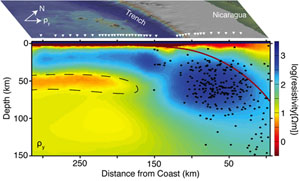 |
|---|
The reason for the excitement is that the sci-boys believe this magma is one of the primary factors or forces that permit the slippage of the Cocos tectonic plate under the Caribbean plate. This slippage is in turn the primary cause of earthquakes in Central America. The magma acts as a lubricant that allows the plates to slip one under the other.
In the image to the right, the magma layer is indicated by the area surrounded by dashed lines while the right side of the diagram shows the Cocos plate "subducting" under the Caribbean. All the black dots are the locations of recent earthquakes off the coast.
I don't want to be a magma pooper but I suspect there's a great distance yet to cover between the new knowledge gained and any practical application that might add in the forecasting of these unnerving episodes.
Hello Aloe
(Slather in On or Swallow It, It's Good Stuff)
GG grew up and lived most of his life in the northern United States, in Massachusetts, Pennsylvania and Ohio. I also lived a few years in Northern Europe (Belgium). In all these places, aloe vera was something that might have been encountered in some store products, but back then it was largely a mystery to me as to where it came from and of what good it was.
 |
|---|
Aloe Vera Plant |
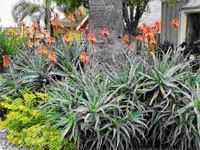 |
Aloe Plants Flowering |
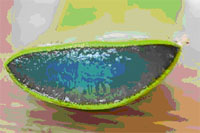 |
Cross Section of Aloe Leaf |
Then I moved to Florida in 1998 and found, outside my condo building, a bunch of plants that I took to be cactus growing wildly. There must have been 15 to 20 sizeable plants grouped in a section next to flowering shrubs and bushes. At first I thought the aloe plants not very attractive as a landscaping plant with no flowers (I came to learn they actually do throw out an orange spike of a flower once a year). When I mentioned them to a neighbor she said "That's no cactus, that's an aloe vera plant" (she said it with an implied 'dummy' in her voice). I learned that aloe vera plants have no relation to a cactus but actually are closer to the lily and onion family.
There was so much for a Yankee to learn living in a sub-tropical zone (Sarasota is #9 in the Growing Zone map). One of the first things I learned was the sun was much stronger at Latitude 27 (Sarasota) then it was at Latitude 41 (Allentown, PA). I would later come to learn that Latitude 9 (Quepos) represented another quantum jump in solar intensity over Sarasota.
 |
|---|
Ouch! |
It wasn't long after arriving on Siesta Key Beach that one day I laid out in the sun a might too long and got a doozy of a sunburn. Arriving back at my condo, my new neighbor remarked on my being a crispy critter (with another implied dummy look stronger that the first). I was in physical pain and she suggested I treat the condition with aloe.
The puzzled look I had on my face only intensified the reflected dummy glare in my neighbor's eyes (she must have been thinking: what are we going to do with these damn yankees?)
She cut just one leaf from one of the plants outside, then cut about a six inch section of it from the thickest part.. Next, she showed me how to trim the spikes off the sides with a sharp knife, cut the piece in half through the center running the blade all along the length of the frond, revealing the slippery, slimy juice in the center. I was then instructed to grasp the pieces and rub the juice all over the areas where I was burned. (Her personal cooperation ended at that point; she never offered to do the job herself - damn, another missed opportunity)
GG did as instructed, using almost all the juice in the fronds and I was a bit surprised at how far the two little pieces went. Within a half hour almost all the pain had gone and I knew I was well on the mend. The only after-effect of the aloe was to give a very thin and dry coating over the skin. Later I learned that it's good to give a second treatment of a small amount of baby oil a few hours after using the aloe to return the skin to it's normal condition.
I must say that I've tried aloe-containing products from the stores but don't get nearly the same results as with the plant directly. I don't know whether it's the dilution of the juice or something in the processing that changes the chemical efficacy of processed products, but they're not the same.
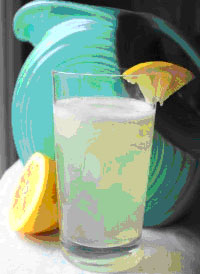 |
|---|
Aloe Lemonade Recipe Below |
| 3/4C sugar 1C water 1C lemon juice (4-6 lemons) 3-4C cold water 1Tbsp of aloe gel per glass |
Costa Rica encompasses Zones 10 and 11, tropical, so aloe plants grow in the wild in many places, particularly in the drier zones. One day a few months ago, I was returning to my apartment in Quepos and my landlady called me over. She was in her kitchen and I noticed that she had some large aloe fronds on the counter.
She turned and offered a piece that had been gouged out of the center of one of the fronds that she had just finished boiling - sort of like a heart of palm. It was my first time actually eating aloe. We munched on it together, she in her kitchen and me at the kitchen window, while she extolled the health benefits of the plant in Spanish, GG catching about 40% of her rapid fire soliloquy.
A couple of weeks ago I went to the beach but forgot my gora (baseball cap) and came home with a terrific burn on the top of my head (you know, the bald spot - or at least balding spot). I remembered that one of the plants on my balcony included a small aloe. I cut a piece, applied it and the sting was gone in 30 minutes.
 |
|---|
Scrambled Eggs with Aloe |
This stuff is great for sunburns. Actually it's great for burns of any kind and is often used in hospitals to treat all but the most severe burns. In addition, aloe has been used successfully to treat leg ulcers resulting from diabetes and is currently being studied as a treatment for certain cancers and blood diseases, including leukemia.
These days aloe is being incorporated into bottled drinks. Most of them are rich in pulp and slightly, pleasantly sweet. Again, I don't know if the efficacy of such products is as good as implied or if there is a loss of strength due to processing like I experienced with the topical products - more to be revealed.
You might want to try some fresh aloe with scrambled eggs, some people swear by this combination. I have yet to try it, but I will soon - the reported taste is similar to mushrooms ..sounds yummy.
¡Pura Vida!
Bocas del Toro, Panama
(A Little Slice of Paradise on the Caribbean Coast)
Three ROMEOS and some assorted family members of one ROMEO recently departed Quepos for a few days to see what kind of trouble we could stir up in Bocas del Toro, Panama, Two of our party had been there before, so there was some guidance, but GG had never seen the place.
 |
|---|
How About a 5 Liter Lamborghini for a Chase Car? |
We elected to take the bus because crossing the border in a rental car or even a personal car often presents problems we didn't want to deal with. Some day Panama, Costa Rica and Nicaragua will probably have a border agreement similar to what the Benelux countrieshave.had for decades. Since the seventies travelers have been able to cross from Holland to Belgium to Luxembourg without stopping. I drove on business from Brussels to Amsterdam a number of times and the expressway between Rotterdam and Amsterdam is straight, flat and unencumbered, a great place to test the strength of your car's engine,.
You just needed to slow down a bit, but not stop, at the border. If the authorities perceived some kind of problem or concern, they sent one of their extra high performance Porsche Targa chase cars after you with two border patrolmen in bright orange helmets (we used to call them moon men). They were very polite to me once when they stopped me and suggested I slow the company BMW I was driving down to about 100 kph (60 mph). "But officer, was I really doing 160 kph, imagine that, I didn't think..."
 |
|---|
The Latest Buses Plying the Quepos-San José Route are Quite Comfortable |
So, for the Panama jaunt, our party of six bought bus tickets for San José leaving on Friday morning, March 1 at 6 AM. We had no way of knowing that our plans would be thwarted at every turn. I guess, periodically, one must take a trip from hell to realize how good all the other trips were or can be. This was one of those frustrating experiences that will be difficult to forget.
The first troublesome thing that happened was when one of the ROMEOS forget his passport at home - he had to get off the bus before we left Quepos and didn't have time to go back home and get it. Actually, because of what happened subsequently, he could later look on himself as the lucky one.
 |
|---|
Taxi Anyone? |
Then, in Parrita, just 14 miles north of Quepos, some taxi drivers decided to participate in a strike that morning. It was something about the latest government authorized fare increase not being enough. They blocked the bridge and highway north of the town, delaying our bus for over an hour until the Policia finally cleared the bridge. Because of the delay, our party just missed the ten o'clock connection in San José for the bus that goes to the border.
And there was no later bus to the caribbean-side border crossing (at a town called Sixaola) because a later bus would not make it in time for the 5 PM daily closing of the border. So, what to do. We formulated a plan to take another bus that didn't go to the border, but did terminate in a town close to it, a town called Manzanillo. The bus also stopped in Puerto Viejo just north of Manzanillo and GG knew a hotel owner there who he was sure would provide good lodging for the night. Not. The hotel was full up but the owner was very kind and had one of his people call around to find us rooms, which he did, not too far from his hotel.
Our friend the hotel owner also told us about a shuttle that ran from Puerto Viejo to the border. We called and signed up five of us for an 8:30 in the morning pick-up at the hotel. We were not certain at the time if the shuttle would only take us to the border or go beyond. We were happy to learn the next day that the shuttle not only continued on the other side of the border but also included the water taxi from the mainland to Bocas, which leaves from a town called Almirante.
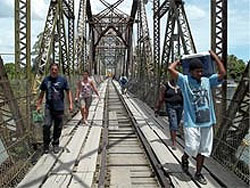 |
|---|
Border Crossing at Sixaola |
The border crossing at Sixaola might be termed rustic (that's a polite term for something rather primitive). On the Costa Rican side there is a small, modern building with two outside windows for passport processing , one for leaving and one for entering Costa Rica. There is enough roof extending over these windows to provide shelter for sizable lines in the event of rain. The bus dropped us off a short distance from this building.
After satisfying CR Passport Control one proceeds across the bridge shown at the right. This is a rickety affair a good 200 yards long that spans a rather wide river called, strangely enough, Rio Sixaola. The walking is precarious for anyone but particularly for we mature folk. A bus driver told me this bridge was once used for vehicles, including buses and trucks, but some time ago had been declared unsafe for that purpose and is now reserved only for humans (I love living on the edge).
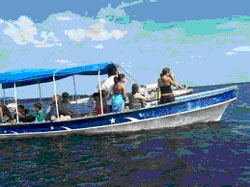 |
|---|
A Typical Almirante/Bocas del Toro Water Taxi |
Once on the other side we found several buildings used to process inbound and outbound visitors but they were considerably more ramshackle than on the Costa Rican side and there was no shelter for the lines waiting to get processed. The gray clouds had already gathered but we were lucky in that there was no rain during the 45 minutes or so we had to stand in line. Once finished with our requisite duties at the border we boarded another shuttle van and headed for the coast and water taxi in Almirante.
After about an hour's ride we were disgorged at the water taxi office. The last leg of our journey involved a boat ride in a short, wide vessel with a Bimini top, like the one in the picture, but in our case the boat was completely full, four abreast. We thwap-thwapped our way across the bay over small waves for about a half hour. Finally, arriving in Bocas del Toro in early afternoon on Saturday, we took a five minute land taxi to our hotel named, ironically for this weekend, Panama's Paradise.
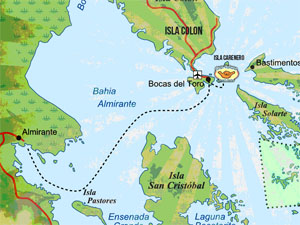 |
|---|
The Islands of Bocas del Toro and Almirante Bay |
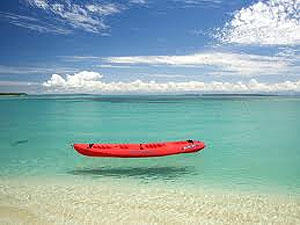 |
This was the Promise - A Beach on Nearby Bastimentos Island - the Raft is not Levitating -
It's just That the Water is So Clear |
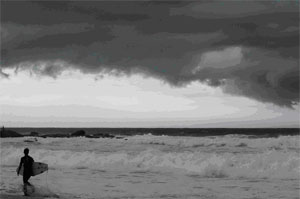 |
This was the Reality for the Weekend |
On the first afternoon we took a bit of a walking tour of the downtown area but the weather was worsening and we put off any island touring until the next day. Travel guides and web sites about Bocas del Toro abound with incredible pictures of white sand beaches and crystalline waters and that was exactly what GG wanted to see.
Bocas del Toro (literally, "Mouths of the Bull:) is actually a series if islands, some large and many small that surround a bay named after the town where we caught the water taxi, Almirante. The town of Bocas del Toro is located on the southern tip of the largest island called Isla Colon (I'd like to have a 100 colones for every place or thing in Central America that's named after Christopher Columbus).
The town is laid out almost entirely in squares about 6 blocks north to south and nine blocks east to west, a little larger than Quepos proper. The presence of tourists is even more pronounced here than in Quepos. My guess is the downtown was running about 3:1 tourists to locals while we were there, at least it seemed that way..
On Sunday the weather worsened. It was actually chilly, the wind picked up and the rain at times came in squalls. Running around in a water taxi tour from island to island became impractical at best.
To make matters worse, one of our party came down with a debilitating stomach virus that required a visit to the pharmacy for suggested medicine. Unfortunately, the afflicted young man would have to suffer that bug for three days and include a hospital visit for specialized IV treatment. It's one thing to be disappointed about the weather but suffering such an illness on top of the bad weather would depress anyone. Our boy grinned and beared it as best he could.
The original plan was to return on Monday, March 4. GG elected to stick to this plan because of some commitments in Quepos while the family decided to stay another day to allow for further improvement in the patient's condition.
 |
|---|
The return trip involved 1) taxi to the water taxi, 2) water taxi (2-3 foot swells and white caps plus double thwap-thwaps to soothe the bad back), 3) taxi to Chainguinola to pick up the bus - about 45 minutes, 4) bus to the border, 5) reverse of the border clearing process including another walk across the infamous bridge, 6) bus to San José (stopping in Limon for a nature and food break, where GG took a tumble and injured his leg), 7) taxi from the Caribbean terminal in San José to the Tracopa terminal on the other side of San José, 8) bus to Quepos.
Total elapsed travel time: 13 hours.
I still have to see those fantastic outer islands, the white sand beaches and the crystal clear water but I think next time I'll go by air. That would reduce the ten hour travel time in steps 1-7 above to 45 minutes and give GG a better temperament once arrived..
¡Solo Bueno!
Uncle Chepito
(Staying One Step Ahead of the Nuns)
The oldest man in the world right now is a Japanese gentleman named Jiroemon Kimura, born April 19, 1897 That makes him 115 years old going on 116 this month.
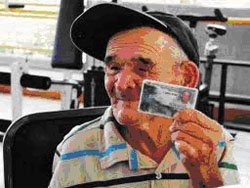 |
|---|
Chepito Displaying His Citizen Card with His March 10, 1900 Birth Date |
Following close behind (but in a field of about ten others) is a Tico named José Delgado Corrales. José is affectionately known as "Chepito" (see What's-in-a-Word section below for the significance of this name). Chepito was born in 1900 and celebrated his 113th birthday on March 10 of this year with a party at TGIF Friday's in the San José suburb of Escazu. He did the same in 2012.
Chepito lives in a nursing home in the Central Valley (Santa Ana, more or less a suburb of San José) where he gives the nuns attending him a run for their money. In the past he has often taken a daily jaunt around the neighborhood where some residents would offer him fruit, even invite him to stay for dinner.
Watch Chepito Dancing When He was Much Younger - at His 112th Party! |
|---|
Lately Chepito has been restricted more to the home because he's lost his hearing and much of his sight. But that didn't stop him recently from scaling the gate (!) and going for a walk anyway. It's hard to keep a good Tico down. I'm sure he was ecstatic about attending his birthday party at TGIF Friday's, which has become a national event (see video).
One of the things that hit me when I was reading about Chepito was that he could easily have been my uncle under the right circumstances. I was the youngest of six children and born in 1943 when my father was 44. In turn dad was the youngest of thirteen children and was born on June 6, 1899, almost a year before Chepito. So, had we been family, the old dude in Santa Ana could easily have been my tio or uncle. Hola, Uncle Chepito!
Furthermore, my grandfather, who I never met, could have easily been around when Lincoln was president and my great grandfather would have likely seen the election of William Henry harrison in 1840 and the conclusion of the Seminole war in Florida in 1842. Of course my great grandpop would likely have seen these events from Quebec as he was reportedly the one who immigrated to the U.S. making my grandpop a first generation American.
I'll stop here - I don't want to claim passage on the Mayflower. After all that genealogy amigos, I'm feeling really old now. I think I'll take a nap.
What's-in-a-Word
Panama
Although no one knows for sure. the word "panama" is thought to be the one used by indians along the isthmus where Panama currently is situated. When interrogated by the conquistadors looking for the city of gold, El Dorado, the indians reportedly would respond with "panama!" meaning "over there!". This was probably just intended to get the Spanish dudes the hell out of town.
 |
|---|
An Authentic "Panama" Hat |
Apparently there are other words that sound similar to panama in the local indian dialect and they mean "abundance of fish" or "abundance of birds", both of which today's Panama has an abundance. This definition is often quoted in the travel press as the true meaning of the word. Maybe, maybe not.
 |
|---|
What we do know for sure is that the so called panama hat did not have its origin in Panama but rather was first produced, and still is, in Ecuador.
An authentic "panama hat" is made from the plaited (braided) leaves of a certain type of palm tree called the toquilla palm or jipijapa palm which is prevalent near the equator. The use of braided construction created a very porous material that is cooler in the tropical heat because it breathes well. It's also light weight and good looking.
The panama hat was first popularized by President Theodore Roosevelt after he visited the Panama Canal back in the early 1900's when it was under construction. He showed up wearing the hat which immediately became known as a "panama hat".
Old Rough and Ready looked mighty dapper in that hat.
Chepito
Chepito is a relatively rare Spanish name given to a baby boy. The origin is Hebrew where the name means "God will increase", The meaning or connotation in Spanish is close, "God will multiply".
One web site offers a characterization of the name Chepito this way: "People with this name have a deep inner desire for love and companionship, and want to work with others to achieve peace and harmony".
Works for me.
Red
In the Rumble Talk section above, reference was made to the Red Sismológica Nacional, one of the organizations that monitors earthquakes here. When I first saw the term "red" used I was curious why so many organizations were called that, why the color designation? Turns out that RED in Spanish, or at least in the colloquial here, means "network". Live and learn amigos.
ROMEO Corner
(Retired Old Men Eating Out)
Mar Luna - Manuel Antonio
Location: Almost to the top of the hill heading for the beach from Quepos, on the right or ocean side.
Hours: Lunch, Dinner, Monday thru Sunday.
Parking: Limited at the restaurant.
Contact: Tel.: 2777-5107; Email: N/A; Web site: N/A
Reviewing ROMEOS: Brian K., Brian M., Tim D., Anita M., Bob N.
To Review Our Rating System and Procedure, go here: R.O.M.E.O. Rating System
Several of us hadn't been to this restaurant since long before the ROMEO Club was formed, so we were anxious to see what, if any, changes had been made.
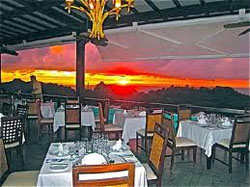 |
|---|
| View from Mar Luna Dining Room |
We arrived near the sunset hour and since this restaurant is situated with a great view of the Pacific, the beautiful sunset was only muted by some thick clouds and haze that had formed in the area.
The dining room is medium sized, perhaps a seating capacity of 50. The room is open to the atmosphere, the hills rolling down to the Pacific and the sunset. We and one other table were the only ones there during our visit
The table cloths and napkins were linen and there were candles on the table. The chairs, however, were those Tico-typical rock hard wooden variety that are of no consequence to the younger but a pain in the you-know-what to the mature in age (I speak of meself of course). The rest of the restaurant is rather nondescript and we set the atmosphere rating at three and a half sloths.
Several of us commented on how cool and inattentive the service was. After waiting 10 minutes, we had to ask for drinks, we eventually had to ask for the candles to be lit and we had to ask for our orders to be taken. At the end of the meal one of our party, a business owner who's lived here 38 years and who was used to receiving a "descuenta locales" (a discount for locals) and had received such in previous years, was rebuffed when it was requested. Our overall service rating slipped to two sloths.
GG and another ROMEO had a fresh tuna steak, cooked to our request (rare). My version was called the chef's recommendation and the steak was sauced with a light bechamel containing chopped capers and a little pepper. It was delicious. The salad and vegetable medley served with the tuna were fresh and very tasty. The plain tuna steak enjoyed by another ROMEO was also deemed good. Another ROMEO had a fish filet with a white sauce containing chunks of hearts of palm. This was reported as very good also. Yet another ROMEO had a simple arroz con pollo (rice with chicken) and came to the same conclusion. |
 |
|---|---|
$$$$ |
|
Value Index = 88 |
The menu selection for desserts was very limited (the usual tres leches, chocolate cake and some other less than exciting offering) so we elected to go to Emilio's up the street for dessert (we're saving Emilio's for another review).
For food quality we give Mar Luna five sloths. With a rating of three and a half sloths for atmosphere, two sloths for service and five sloths for food quality, we arrive at an overall rating for the restaurant at three and a half sloths.
With regard to cost, this place did not come in cheaply, We cringed a bit when opening the menu as we sat down. There were several main courses of seafood that were in the 20,000 to 30,000 colone range ($40-60) and one lobster tail dish priced at 40,000 colones (almost $80). My tuna steak and two cokes came to 13,250 colones (billed also as $28 on the tab - that's a poor exchange rate of 473 colones to the dollar when the bank rate is about 493 which means they.re getting another 4% on the exchange rate). This pricing puts Mar Luna in the 90 percentile of restaurants here with only a few places more expensive.
This also puts it in the high end of the four $ rating and results in a Value Index of 3.5 sloths/4$ = or 88, putting the restaurant in the bottom third of restaurants ranked to date for value.
So if you want a good view and very good food and don't mind spending a goodly amount to get it, Mar Luna is an option for you.
don Beto de Quepos, El Gringo Dorado Pura Vida! |
Be pithy but kind. I'm sensitive. |
|---|

